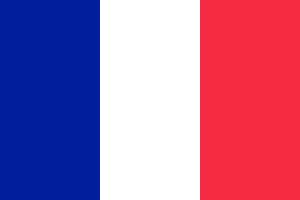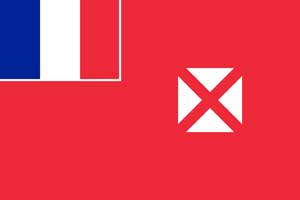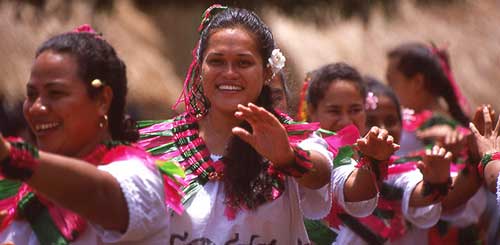POP Cultures: Wallis and Futuna
Map
Flag

Unofficial flag

Quick facts
Official Name: Territory of the Wallis and Futuna Islands
Indigenous Peoples: Polynesians
Official Languages: Wallisian, Futunan and French
Political Status: French overseas territory, called an island collectivity
Capital: Mata-Utu
Population: 15,500 (2014 est.)
Greeting: Mālō te ma’uli
History and geography
Wallis and Futuna is an Overseas Territory of France in the South Pacific between Tuvalu to the northwest, Fiji to the southwest, Tonga to the southeast, Samoa to the east, and Tokelau to the northeast. The islands’ land area is 142.42 sq km (54.99 sq mi). Mata-Utu is the capital and biggest city. The territory is made up of three main volcanic tropical islands and a number of tiny islets. It is split into two island groups that lie about 260 km (160 mi) apart, namely Wallis Islands (Uvea) in the northeast, and Hoorn Islands (also called the Futuna Islands) in the southwest, including Futuna Island proper and the mostly uninhabited Alofi Island.
Polynesians settled the islands that would later be called Wallis and Futuna around the year 1,000, when the Tongan Empire expanded into the area. The original inhabitants built forts and other structures on the islands, the ruins of some of which still can be found. While Wallis primarily was a part of Tonga and shares its language and customs, Futuna maintained close cultural ties with Samoa and Rotuma (Fiji).
Dutch and British forces came upon the islands in the 17th and 18th centuries. Navigator Jakob Lemaire and Willem Cornelis Schouten sighted Futuna and Alofi in 1616. British explorer Samuel Wallis in 1767 visited Uvea. But it was the French who were the first Europeans to settle in the territory, with the arrival of missionaries in 1837, who converted the population to Roman Catholicism. Pierre Chanel, canonized by the Roman Catholic Church in 1954, is a major patron saint of the island of Futuna and the region.
In April 1842, the missionaries asked for the protection of France after part of the local population rebelled. In 1887, the Queen of Uvea (on the island of Wallis) signed a treaty officially establishing a French protectorate. The kings of Sigave and Alo on the islands of Futuna and Alofi also signed a treaty establishing a French protectorate on 16 February 1888. The islands were put under the authority of the French colony of New Caledonia.
In 1917, the three traditional kingdoms were annexed to France and turned into the Colony of Wallis and Futuna, which was still under the authority of the Colony of New Caledonia.
During World War II the island’s administration was pro-French until a Free French corvette from New Caledonia deposed the regime in May 1942. Units of the US Marine Corps landed on Wallis in May 1942. In 1959, the inhabitants of the islands voted to become a French overseas territory, effective in 1961, thus ending their subordination to New Caledonia.
Political power under the statute is divided among the Territorial Assembly, the Superior Administrator and three Circonscriptions (electorates) which include the customary structures of Wallis and Futuna’s monarchies. There is no executive government and the territory does not have the level of autonomy France’s other Pacific territories, New Caledonia or French Polynesia do. There is a representative each in the French Senate and the French National Assembly. Each Circumscription is headed by a king who deals with cultural and religious matters and rituals. The king also has customary authority and controls land ownership and use.
About four-fifths of the people rely on traditional subsistence agriculture, with about 80 percent of the labor force earning its livelihood from agriculture (coconuts and vegetables), livestock (mostly pigs), and fishing.
Most of Wallis and Futuna’s revenues come from French government subsidies, licensing of fishing rights to Japanese and South Korean companies, import taxes, and remittances from expatriate workers in New Caledonia. Imports, mainly from France and Australia, include food, machinery, vehicles, and building supplies.
Uvea is more developed than Futuna. The French administration is located in Uvea, where there is better infrastructure. Its roads and public services are superior, and most households have running water and electricity. The government is the largest single employer. In contrast, Futuna is somewhat isolated; there is only a partially surfaced road circling the island, and administrative positions are scarce. Because of their relative isolation, Wallis and Futuna attract few tourists. The population is about 15,000, but there is a Walis and Futunian community in New Caledonia that numbers about 35,000 people. The people of Wallis and Futuna are very religious, primarily Roman Catholic.
Arts and culture

The culture of Wallis and Futuna is Polynesian, and is very similar to the cultures of its neighboring nations Samoa and Tonga. The Wallisian and Futunan cultures share similar components of language, dance, cuisine and modes of celebration. Marriages and extended families are important in Wallis and Futuna, with marriages controlled by the family and normalized by the Catholic Church. As in other Polynesian societies, both sons and daughters inherit rights to the land, but males are responsible for working the land and making it productive.
Important symbols of culture include tapa or barkcloth, and kava.
Kava is a drink made from the pounded root of the pepper tree and is consumed during certain ceremonies and rituals. The bowls in which kava is served are also important for honoring chiefs.
Tapa cloth is made by women from the bark of the breadfruit tree. The barkcloth is usually decorated with designs carved onto a template and then stamped with colored dyes on the surface of the cloth. Tapa is used for exchange rituals that keep families closely tied to each other.
Woven mats are also important as funeral gifts.
The Lompieau canoe, a large traditional canoe that could carry 100 people, is a strong symbol of the connection of the people of Wallis-Uvea with Tonga and the seafaring heritage of these Polynesian peoples.